BALLOCH CASTLE, Balloch
ACCESS : Easy and pleasant access to the extenive grounds. You can approach the castle, but it is not open to the public.
Listing : A
///lion.armrests.heartened Castle
https://w3w.co/whizzed.forks.retaliate Walled Garden
///purse.wider.remix East Lodge and east entrance
///crowds.dictation.rigid South Lodge and main gate
///bangle.butternut.robes Main carpark
Parking : Near the south gate on Balloch Road OR down a road off Balloch Road (turn at St Kessogs Church) OR within the grounds near the castle approached down a driveway off Mollanbowie Road.
Pedestrian access : Walkers can use the same access points as for parking and also enter down a path alongside the Balloch House Hotel next to the bridge.
This is more grand house than castle, but it is imbued with a castle aura and grandly overlooks the lower reaches of Loch Lomond. The present building was built in 1808 for John Buchanan of Ardoch. It was designed by Robert Lugar, who also designed Tullichewan Castle. John Buchanan was one of the original partners in the Glasgow Ship Bank and he signed all the bank notes at the castle.
The listing descriptions says : Robert Lugar, 1808-09. Castellated Tudor-gothic. Stugged squared sandstone, ashlar margins and dressings. String course; hoodmoulds; battlemented parapet; battered base course; blind cruciform arrowslits.
Today it sits a liitle forlorn and empty. Occasional work on it has given it the will to survive, but it desperately needs a new purpose in life, besides that of scenic backdrop.
The grounds are well worth a visit. They provide great walks amongst tall trees across lawns and down to the Loch. There is a well maintained and pretty walled garden. At the shore there is a slipway, sometimes used for boating events, and a small kiosk.
Two gate lodges remain : one at the main entrance off Balloch Road, and one on the east side off Mollanbowie Road.
Something that is historically important, but which is passed daily by many walkers completely unaware of it, is the site of the original castle down near the shore. This was the previous or "old" Balloch Castle. Although little can be discerned now, you can make out the mound and the form of a moat.
The old Balloch Castle dates from 1238 and was the historic home of the Earls of Lennox who lived there during the medieval period. The Lennox family had been given the land and titles in 1072 by Malcolm III, son of Duncan who was murdered by MacBeth. The Earls of Lennox did not consider Balloch Castle to be safe enough from attack, so around 1390 they abandoned it and moved to the security of a new castle on the island of Inchmurrin. [WDC].
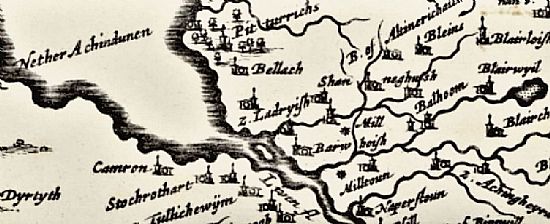
Extract from "Levinia Vicecomitatus. The Province of Lennox, called the Shyre of Dun-Britton", by Timothy Pont, c1560-1614. The castle is labelled here as "Bellach" simply with a symbol of an important building. That island is the one next to Balloch House Hotel. A small burn that runs close by is easily recognisable when you visit.
NLS ©
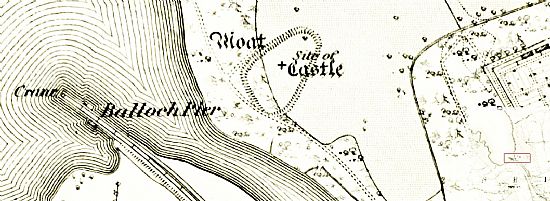
In this OS map of 1860 you can see the site of the old castle marked by a motte ie a mound. It looks more extensive on the map than today. Some earth and stonework have perhaps been removed for reuse elsewhere. Any timber structure would have naturally disappeared. The label also notes a moat although that is little more than where it reaches onto the river bank. (Why would one have a moat facing a river?) More a place to pull up boats than defensive, but the river starts to flow swiftly at this point as it leaves the Loch so this may have had some strategic benefit. The later walled garden can be seen to the right. NLS ©
In this map by Pont you can see Loch Lomond where it enters the Leven. The estate is labelled Balloch. Two large buildings are shown. The original castle would have been the one nearer the river. The other one is unknown, perhaps the stables. strangely near where the later one, not then constructed, still is.
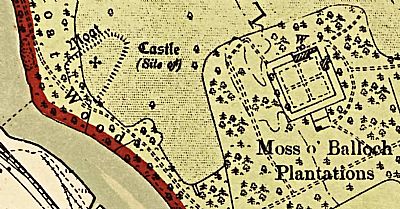
This is an extract from the estates map (for the full map see the link below). It dates from 1916, but the old castle site is still shown as a distinct flattened mound. That may be just a simplification. No sign of a moat though, confirming that any moat that did exist disappeared and what you see today is more to do with the build up of the pathway. The walled garden sits within the Moss o'Balloch Plantations. NLS © as ref below.
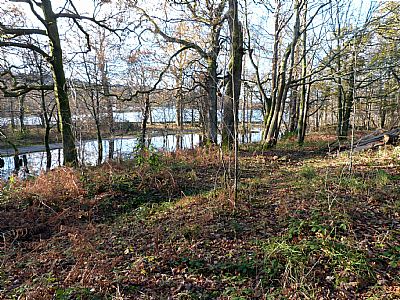
The area where the original castle stood comprises several mounds, undulations and depressions. While some of that may have existed back then, much is the result of disturbance to the soil for recovery of stone for building of the newer building, drainage of the slightly marshy area just up from here and during replanting. The Leven is the further of the two visible strips of water. The nearer one is what appears as a "moat", but which is formed by the raised path. Remember too that the Loch was not as high as it is today, even during heavy rains. (The barrage downstream keeps the level high RIVER LEVEN BARRAGE)
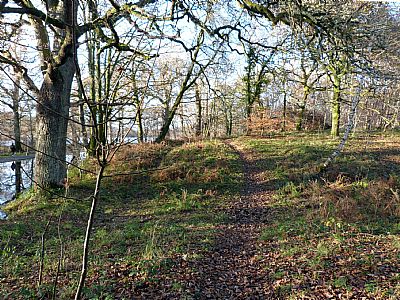
A similar view with a worn track over several mounds.
The old castle continued in the hands of the Darnley branch of the House of Lennox until 1652 when James, fourth Duke of Lennox, sold Balloch Castle to Sir John Colquhoun of Luss.
At the beginning of the nineteenth century John Buchanan of Ardoch acquired the Castle and Estate. He used stone from the walls of the ruined castle to build a castellated mansion nearby. This mansion is now commonly known as Balloch Castle. [WDC].
Joseph Irving writing in 1879, about the district and who owned what, notes how the Earls of Lennox had made good use of their various properties in this area including the lands of Luss. Amongst their properties was the original Balloch Castle. This lifestyle was disrupted James 1.
On the subdivision of the earldom in the fifteenth century, the stronghold of Balloch was retained in the hands of the Darnley family, who, on more than one occasion, entertained their sovereign within its walls. It seems to have been gradually abandoned, however in favour of Inchmurren, which as early as 1511, is described as the chief messuage of the earldom. No portion of the original castle at Balloch remains, but it is known to have been situated to the edge of Lochlomond; the fosse, which could thus be readily filled with water as occasion required, still exists, and, encircles the knoll on which the castle stood. On making a slight excavation in that quarter some years since, certain pieces of timber, firmly bound together, were found in a position corresponding with that where the drawbridge may supposed to have sthgyyu ood. [Irving].
He goes on to mention the new castle that overlooks the site of the old one.
In the 19th century, the land was acquired by John Buchanan of Ardoch, who erected a castellated mansion on the estate, from a design by John Lugar.In 1830, it passed into the hands of Gibson Stott, Esq., who greatly improved and adorned the grounds. [Irving].
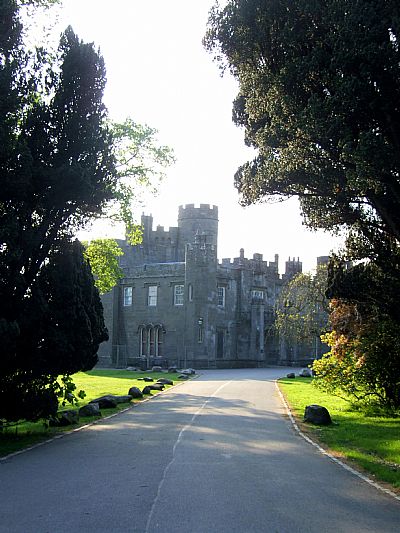
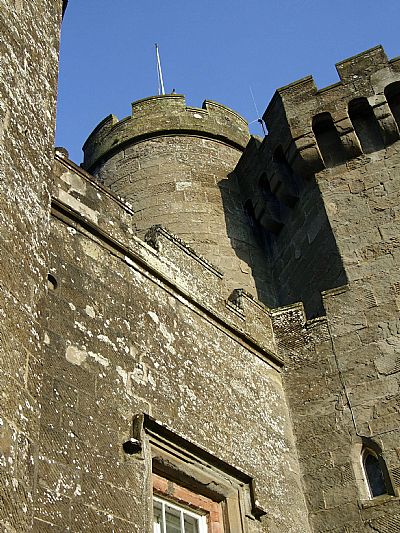
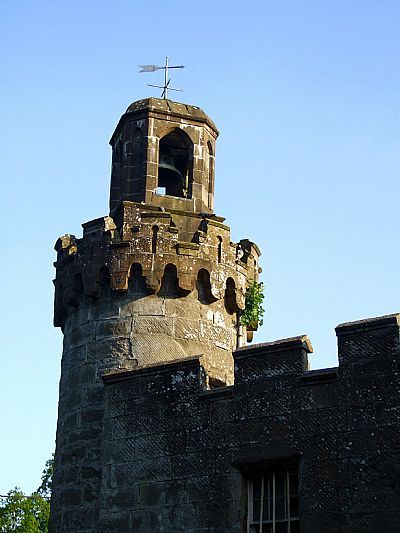
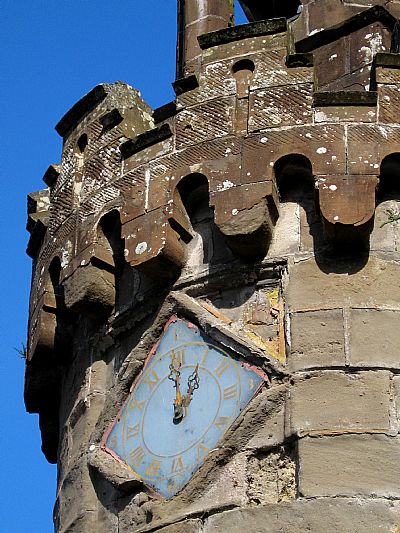
Balloch Castle
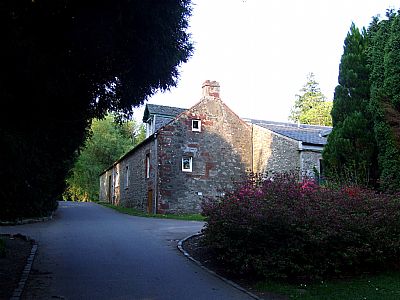
The stables block
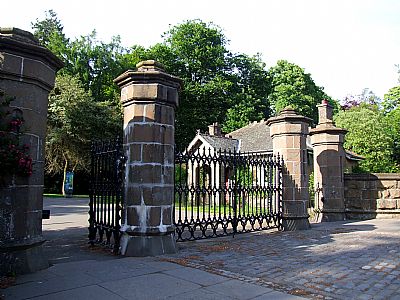
South Lodge
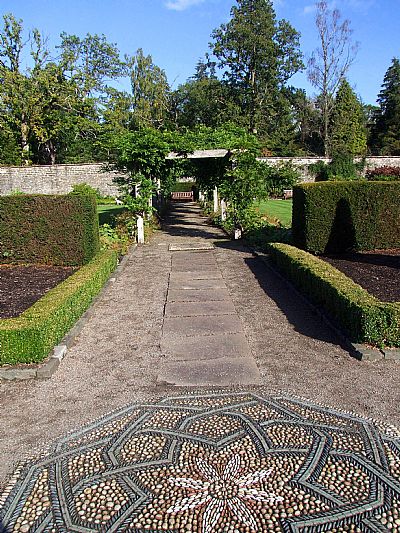
The walled garden
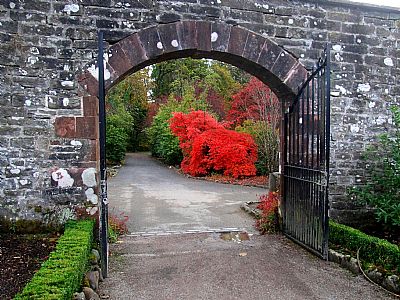
The walled garden.
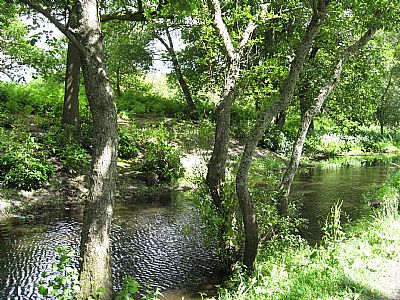
The mound is the approximate location of the original castle.
Its moat was probably here, but subsequent disturbance to the land including the passing path have affected it. What you see today is more to with the path being raised.
BALLOCH PARK GUIDE : https://ballochparkguide.com/ and https://play.google.com/store/apps/details?id=com.parkdirection
BRITISH LISTED BUILDINGS website : https://britishlistedbuildings.co.uk/200330329-balloch-castle-bonhill#.X9E57qFxdPY
IRVING, Joseph. The Book of Dumbartonshire. Volume II Parishes. 1879. W. and A. K. Johnston. Edinburgh and London.
NATIONAL LIBRARY OF SCOTLAND (NLS) : Maps reproduced with permission.
1560?-1614? map : Archive title : "Pont, Timothy, 1560?-1614?. Levinia Vicecomitatus. The Province of Lennox, called the Shyre of Dun-Britton / [by Timothy Pont] . https://maps.nls.uk/view/216547779
1860 map. Archive title : "Dumbartonshire, Sheet XVIII (includes: Bonhill; Dumbarton; Kilmar...Survey date: 1860 , Publication date: 1864". https://maps.nls.uk/view/74426619
1916 map : Estates maps 1750s - 1900s Map Showing Balloch Estate and Loch Lomond Park : https://maps.nls.uk/estates/rec/12088
WEST DUNBARTONSHIRE COUNCIL website : https://www.west-dunbarton.gov.uk/leisure-parks-events/museums-and-galleries/collections/buildings/castles-and-country-houses/castles-and-country-houses-vale-of-leven/balloch-castle/

